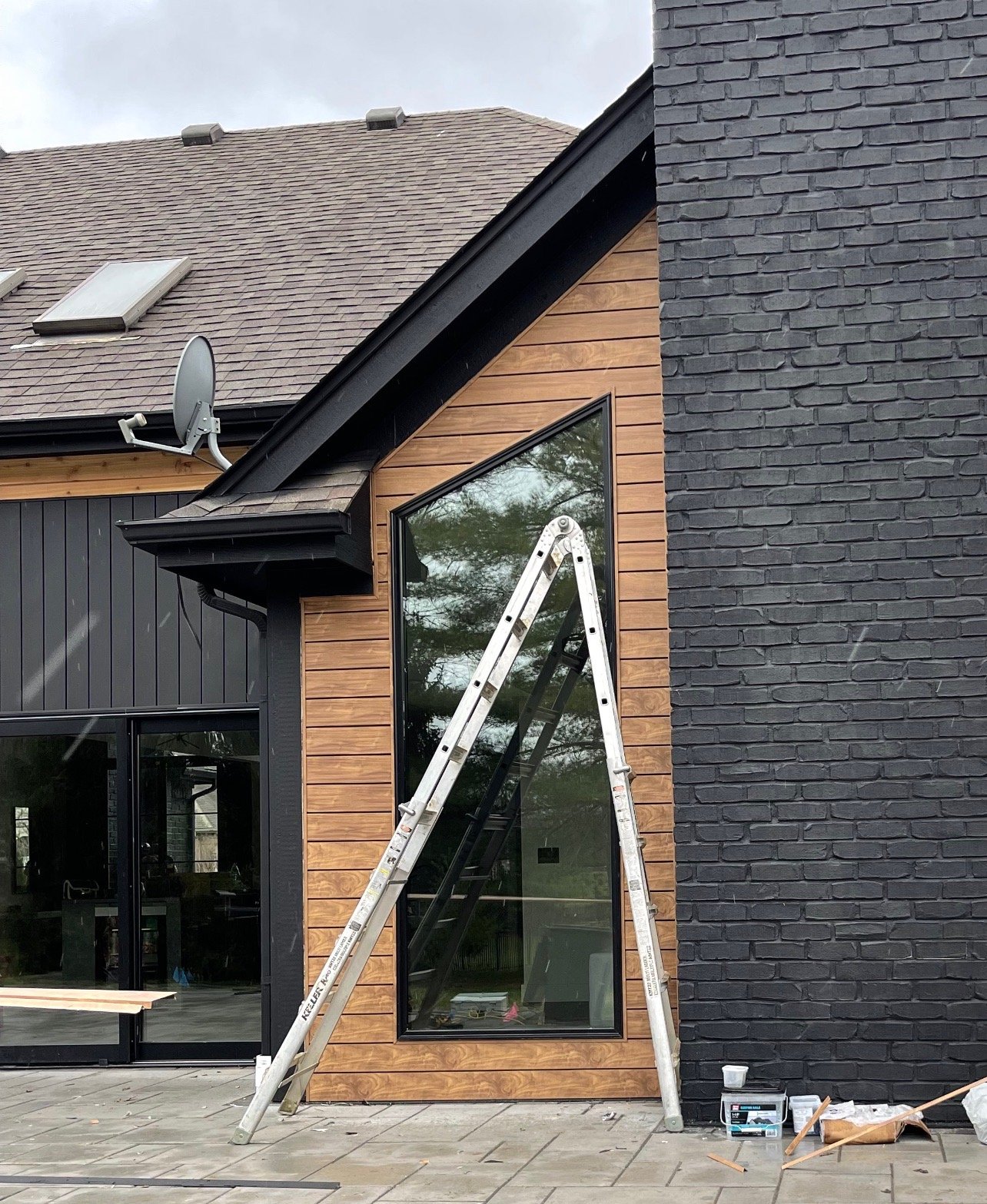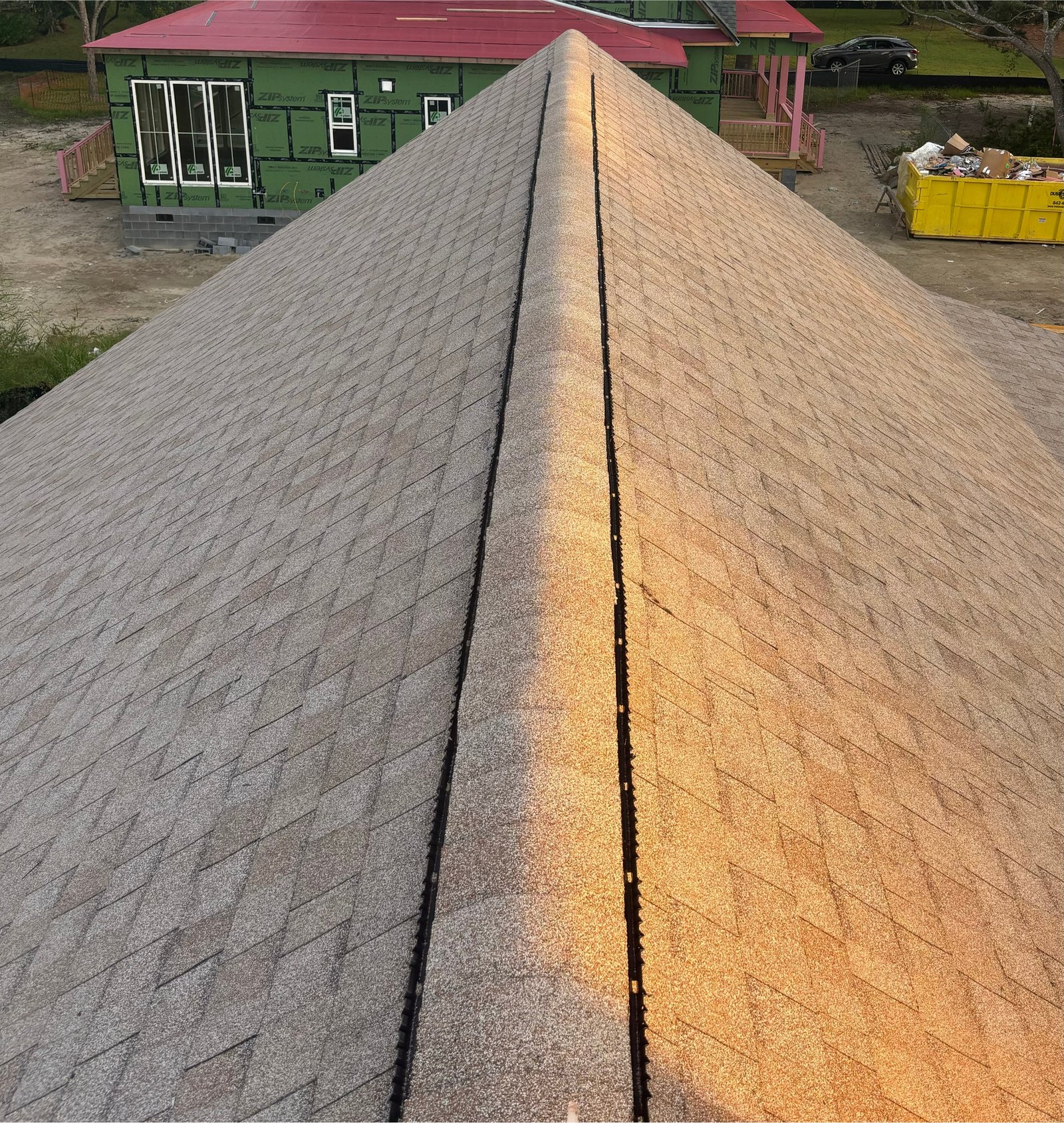What are Roof Flashings?
When it comes to roof flashings, it is critical to not only understand the different types of flashings, but also understand exactly where they are used. Flashings are designed for specific more vulnerable areas of the roof system to divert water away from the area requiring it. There are more than 10 different types of roof flashings that are designed specifically for certain areas of the roof system and all range in various sizes, shapes, and fabrication styles. According to South Carolina Building Code (Section R903.2 Flashings), “Flashings should be installed in a manner that prevents moisture from entering the wall or roof through joints in copings, through moisture permeable materials, and at intersects with parapet walls and other penetrations through this roof plane.” Roof flashings are to be installed to divert water over the roofing material and away from the crevices between roof/penetration junctions.
What are Roof Flashings Made Of?
Flashing is typically made from a thin sheet of metal that creates an avenue for water to flow off your roof and away from the roof penetration, roof/wall intersection, or slope transition. According to South Carolina Building Code (Section R903.2.1 Locations), “Flashings shall be installed at roof and wall intersects, wherever there is a change in roof slope or direction and around roof openings. A flashing shall be installed to divert water away from where the eave of a sloped roof intersects a vertical sidewall. Where flashing is of metal, the metal shall be corrosion resistant with a thickness of not less than 0.019 inch (0.5mm) (No. 26 galvanized sheet).” These metals consist of copper (not very common as it is extremely expensive), galvanized steel, and aluminum. For metal roofs, a common “galvalume” flashing is typically used with the “galvalume” metal roof panels.
What are Common Roof Flashing Mistakes and Problems?
Cracks or breaks in flashings, improper installation of flashings, and flashings used in incorrect areas are huge reasons for roof leaks. The majority of roof leaks come from issues in flashings, not the roofing material itself. Therefore, when installing flashings, it is crucial to install them exactly according to building code requirements and manufacturer specifications.
Also, often, when roof replacements take place, contractors are notorious for reusing the old flashings. They do this because in some situations, the flashings may be too difficult to remove or the customer doesn’t want to agree to a change order to properly do the project as it may increase project costs. If old rusted or corroded flashings are reused, eventually they will fail, causing leaks into the home. This commonly takes place on a sidewall where step-flash is ran behind wood/James Hardie/or LP SmartSide siding. Due to these type of sidings being caulked to finish siding products, the only way to remove them is by cutting the siding back enough to pull the old step-flash out and replace it. Due to the costs and labor associated with doing this, replacing the step-flashing, and then installing another color matched trim board with caulk at the siding/trim junction, contractors sometimes shortcut this area, causing issues later.
Another common area where flashing installation mistakes occur are at headwalls where the apron-flashing is supposed to be installed. Often, contractors will install the apron-flashing underneath the last course of shingles, composite, or wood shakes, leading to water being trapped under these shingles. Due to the shingle having a sealant strip on the back-side, if the apron-flashing is ran behind the shingle in this area, the water will inevitably trap. The proper way to install apron-flashing is over the roofing material, not under it.
Common areas where roof flashings are installed incorrectly are near sidewall, endwalls, crickets, chimneys, pipe penetrations, skylights, and dormers.
What are the Different Types of Roof Flashings?
Step-Flashing: Probably the most commonly used piece of roof flashing is step-flashing. Step-flashing is designed such that it diverts water away from a roof/wall intersect when the sloped roof meets a sidewall. Another term for step-flashing is called “sidewall flashing.” At the side wall, the most commonly used type of flashing in the United States is “step-flashing.” It is also used on the sides of chimneys, dormers, and skylights, and other penetrations that have a sidewall. It is installed in an overlap manner with asphalt shingles and other shingle/panel like roof systems. It is helpful to note, step-flashing cannot be used with “paneled” metal roofs since the metal roof panels are continuous from eave to ridge. Step-flashing is typically 10-inches long and 8-inches wide, with a 90 degree bend directly in the middle. This allows for 4 inches on the vertical sidewall and 4 inches onto the roof. Each piece of step-flash is then installed at the roof/wall junction with each course of roofing material to keep the water running down and over the previous course of shingles/roofing material used.
Counter-Flashing: Counter-flashing is the second layer of flashing that is typically installed over step-flashing where a roof meets a mortared, brick, masonry, or EFIS/Stucco wall, intersects, and/or chimney. After the step flashing is installed with the vertical leg laying flush against the wall, counter-flash is required to be installed to protect water from running behind the vertical leg of the step flash.
For a mortar, brick, or masonry installation, to properly install counter-flashing, it is recommended to grind out a ½ inch mortar joint with a circular-blade mortar saw, blow out the loose dust and mortar from the grinding, fabricate a piece of metal/aluminum/copper flashing with a ½” lip, and tuck it into the mortar joint tightly. After installing the lip of the metal flashing into the mortar joint, used mortar nails, nailed into the mortar, to secure the corner of the lip and prevent it from becoming loose at the lip area. The nail head essentially hugs the lip of the counter-flash into place. The counter-flash then lays over the vertical leg of the step flash to prevent water intrusion. Finally, seal the lip/mortar gap with a bead of silicone roof/flashing sealant to protect against any water intrusion at the lip. (It is important to make sure these bead of caulk looks aesthetically appealing and clean, not globby. Therefore, an experienced caulker should perform this task as it is more difficult than it seems.)
For EFIS/Stucco, the counter-flash lays against the wall with a drip bend at the top to hug the wall. Then, seal the vertical top-edge with a bead of silicone roof/flashing sealant to protect against any water intrusion. (It is important to make sure these beads of caulk looks aesthetically appealing and clean, not globby. Therefore, an experienced caulker should perform this task as it is more difficult than it seems.)
There are “stair-stepped” and “reglet” counter-flashing options. As long as the mortar joints are grinded out and the lip of the counter-flash is tucked into the mortar joint in these two applications, both are optimal at diverting water. Aesthetics play a larger role when determining which option is preferred by the homeowner.
Apron-Flashing (Also known as “Headwall Flashing” and “L-Flashing”): Apron-Flashing is essentially that, an “apron.” This is required when a roof slope dies into the face of a vertical wall. This is also installed at the base of the face of a “dog-house” style dormer where the roof dies into the vertical wall. Apron flashing is meant to flash onto the top of the roofing material for shingles, composite, wood shake, and other similar types of roofing material. For metal roofs, “apron-flashing” is also referred to as “endwall flashing.” When there is siding, the vertical leg of the apron-flashing must be flashed behind the siding such that the siding prevents water from going behind the vertical leg of the apron-flashing. When there is mortar, brick, or masonry, there should be a similar installation like that of counter-flashing above. Grinding out a mortar joint, tucking a ½ inch lip into the mortar joint, fabricating the metal in a manner such that it flashes over the roofing material, and then sealing the lip/mortar joint with silicone.
Drip-Edge: South Carolina Building Code states in Section R905.2.8.5 Drip edge, “A drip edge shall be applied to eaves and rake edges of asphalt shingle roofs where required by the manufacturer. “ When installing drip edge, code also requires the drip edge to have at least a 1-½ inch face as exposed when looking at the eaves or rake edges from the exterior. The hidden portion of the drip edge that gets fastened to the roof needs to extend onto the roof deck at least 2 inches over the underlayment at the rakes and under the underlayment at the eaves, This portion is then fastened to the roof deck mechanically no more than 12 inches apart. When there are consecutive adjacent segments of drip edge, they must overlap at least 2 inches according to building code requirements. Drip edge for asphalt shingle roofs, tile roofs, composite roofs, and wood shake roofs are all designed very similarly, some just have a larger exposed face according to that manufacturer’s specifications. For metal roofs, “drip edge” is referred to as “eave trim” or “rake edge trim.”
Valley Flashing: Valley flashing, according to code requirements, is to be installed in a manner such that the width of the metal valley lining material should be no less than 24-inches wide with corrosion resistant metals. Valley flashing is typically only used in an “open valley” installation method with asphalt shingles, composite roofs, wood shake roofs, metal roofs, and more. When asphalt shingles are installed in a “closed valley” method, metal valley flashing is typically not used. A self-adhered ice and water shield is typically required by code instead of the metal lining.
Skylight Flashing: Skylight flashing is typically ordered as a “skylight flashing kit” that the manufacturer specifically designs for a specific skylight size that they offer. The kits typically consist of three components: a header (head) flashing, step-flashing or sidewall flashing, base flashing, and a self-adhered underlayment flashing to be installed over the nail flange after fastening the skylight to the roof deck.
For instance, a Velux FS S06 Fixed Deck Mount skylight has a skylight flashing kit manufactured and designed for that specific sized skylight. The Velux EDL flashing kit for the S06 model is specifically designed for shingle, slate, and wood shake roof systems as the step flash is manufactured such that it goes with those roof types. The Velux EDW flashing kit is designed for tile roofs only. The Velux EDM flashing kit is designed for metal roofs as the sidewall flashing is manufactured for paneled roof systems. Due to step-flashing only being required for lapped and staggered roof systems, it would not be an adequate flashing for paneled roof systems such as metal.
Skylights are the more vulnerable areas on a roof that typically leak. A lot of homeowners and contractors are scared to install skylights due to them having a lot of bad stigma, but this is simply due to the lack of installation carefulness of the contractors installing the flashing kit. If Velux skylights are installed and flashed properly, they are warranted for 10-years. (See Photo Below)
Vent-Pipe Flashings: Vent-pipe flashings consist of pipe boot flashings around plumbing stacks, b-vent base and collar flashings (b-vent is metal piping used to exhaust gasses from mechanical/gas appliances), and other vent penetrations coming out of the roof. These flashings consist of a metal base flashing with an additional collar that hugs tight around the pipe coming out of the roof. For plumbing stacks, typically 1.5 inch – 4-inch pvc piping, metal pipe boots with a neoprene rubber sleeve hugs around the pipe to prevent water from running down the pipe into the home. For b-vent piping, there is a metal base flashing that goes at the base with an additional collar piece that flashes the pipe and the base.
Cap Flashing (Coping Metal): Cap flashing, or also known as “coping metal,” is typically installed on flat roofing applications where there is a parapet wall. At the top most portion of the parapet wall, typically after the flat roof membrane is run up and under the horizontal portion of the top of the parapet wall, the coping metal sits. The coping metal is then fastened into the exterior side of the parapet wall perpendicular to the vertical leg of the flashing. This is to mitigate the chance of water leaking into the fastener hole. This coping metal then typically is fabricated in a manner to have a ¼ inch drip edge at the bottom most portion of it to divert water away from the wall.
Base Flashing: Base flashing is most typically seen at the bottom most, or “base,” of the chimney. This base flashing is similar to apron flashing but is more commonly known to be used around a chimney, bottom of a skylight, or bottom of a vertical wall (Similar to Apron Flashing). There is also “base flashing” included in a skylight flashing kit and is the piece installed on the bottom side of a skylight, nearest to the eave of the roof system.
Diverter/Kick-Out Flashing: A diverter, or also know as a “kick-out flashing” is installed at the eave portion of a sloped roof where that slope meets a vertical sidewall. This piece of flashing ties in with the first piece of step-flash on a shingle roof to ensure water is diverted into the gutter and away from getting behind the siding material at this area. The water runs down the step flash, into the diverter, and then into the gutter. When properly installed, the gutter should sit 1” from the sidewall to prevent water from being trapped between the endcap on the gutter and the sidewall cladding material.
When is the best time to install roof flashings and how much do they typically cost?
Roof flashing is best to be installed during a roof replacement as it is the optimal time to ensure the underlayment, substrates, and roofing material is also installed correctly to ensure the flashing does its job. If the flashing is installed correctly, but the underlayment or roofing material is installed incorrectly, leaks can also occur. It is important not to just “band-aid” roof flashings, but properly fix them while also ensuring the roofing material is installed properly. Depending on the size of the flashing replacement or installation, the cost can vary anywhere from $25 – $700. The more metal flashing fabrication required and difficulty of the flashing installation, the more expensive it is. The most inexpensive flashing replacement being a neoprene pipe boot flashing replacement, which take only a few minutes.
How to Make Sure Your Roofing Contractor Actually Understands How to Properly Install Roof Flashings?
If a roofing contractor doesn’t understand the different type of flashings, how to properly install them, nor where specific flashings are specified to go on a roof system, you very likely will experience leaks in the future. Roof flashings are the most critical roof accessory component to keeping water out of the home. Since flashings are installed at all of the vulnerable areas on a roof system, it is of most importance that they are installed correctly. As a homeowner, it is crucial to truly understand the different roof flashings, where they go, and how they are installed so that you can ask your potential contractors installation related questions to ensure they truly understand roof flashings. Not only should you ask flashing installation related questions, but you should also ask other roof system installation related questions. For some question ideas, read our guide on “Roofing Installation Questions to Ask Roofing Contractors.”
Author
-

Myself, Brent Bauer, and my amazing wife Ashley Bauer, founded Transform Charleston Roofing, Siding, Gutters, and Custom Exteriors with the passion and purpose to serve, love, and help people TRANSFORM their lives through self-development. We found that this is the secret to true fulfillment. This leads to our passion, as well as our “Why” as the Bauer’s.





